Any hobby you pick up is going to have specific tools of the trade. When I started quilting in 2008 I had no idea what I would need.
I borrowed a sewing machine from a friend, went to a box store for some fabric, and got started. I’m sure I figured out how useful rotary cutters and mats were, because I know I didn’t use scissors to cut out my pieces. But other than that, things were pretty basic. I think I even used the thread on the machine I borrowed.
Now days, there are a lot of tools I use and love every day as I create new quilts. Let me share some of my favorites with you.
Must Have #1
My sewing machine. Obvious, I know, but it wasn’t until quite a few years into my beloved hobby did I realize exactly how much of a difference a good machine makes. More on that another day, but a good reliable machine is a must. My two favorites have been my 20 year old Juki TL98e and my Janome MC6700p. The newer Juki 2000 and 2010 models are great.
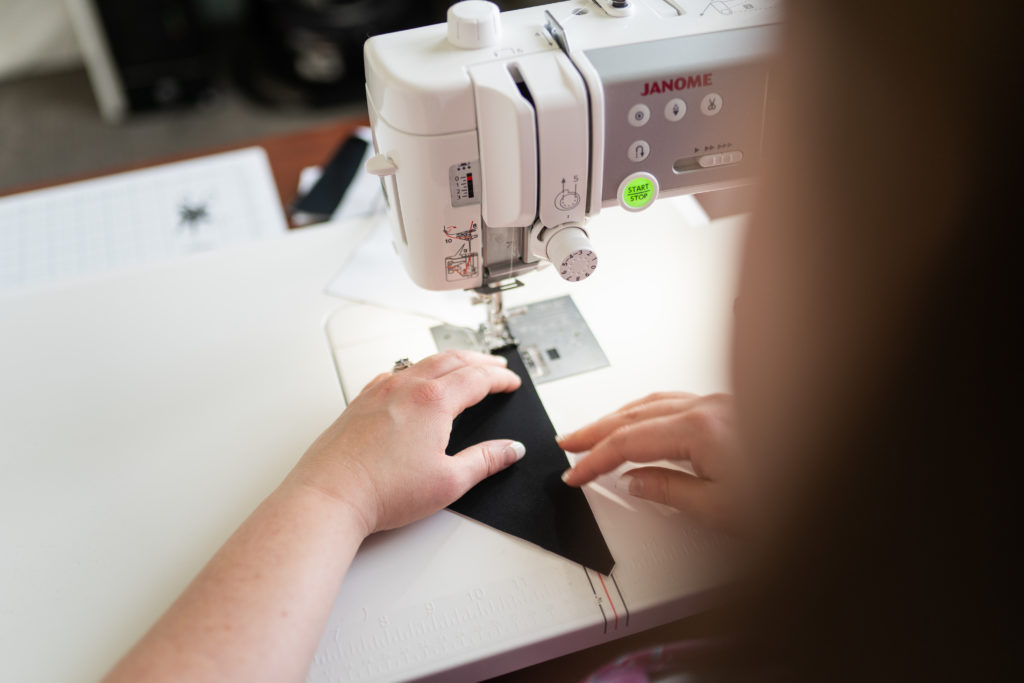
Must Have #2
Fabric. Again, a little obvious, but that first time going to the fabric store, I had no idea there were so many choices! Not only in print and design, but in quality. I purchased that first go around some sparkly, thin, hard to work with fabric that made my life miserable. Thankfully at the time I was at least sewing on a good machine, but the fabric made things so much harder. Quality fabric matters. If you are just starting out, get the good stuff and find a local QUILT shop to get it from. The clerks know what they are talking about. They will help you. Do yourself a favor and don’t get fabric at a big box store if you can help it. If you don’t have a local quilt shop, there are many online, or you can still get some good stuff at a big box store, you just have to be a little more careful.
Brands to look for: Moda, Robert Kaufman, Art Gallery, Free Spirit, Figo, Windham, Andover, Cotton and Steel, RJR, Riley Blake and probably a few more that I am forgetting. Stick with these manufactures of fabric and you will be much happier throughout your project.

Must Have #3
Quality thread. I had no idea when I started that there was a difference in threads. There is still lots of things I don’t know about thread weights, etc. I do know that low quality thread does you no favors though, and it really isn’t as inexpensive as you think it is when you factor in how many yards you get. My favorites are Aurifil for cotton (which I use for piecing and quilting), and Mettler for polyester (you need a good poly for bags). Other good brands are Gutterman and Superior Threads. Your machine might have a preference, so don’t buy a whole ton of one brand until you have found one that you and your machine agree on.
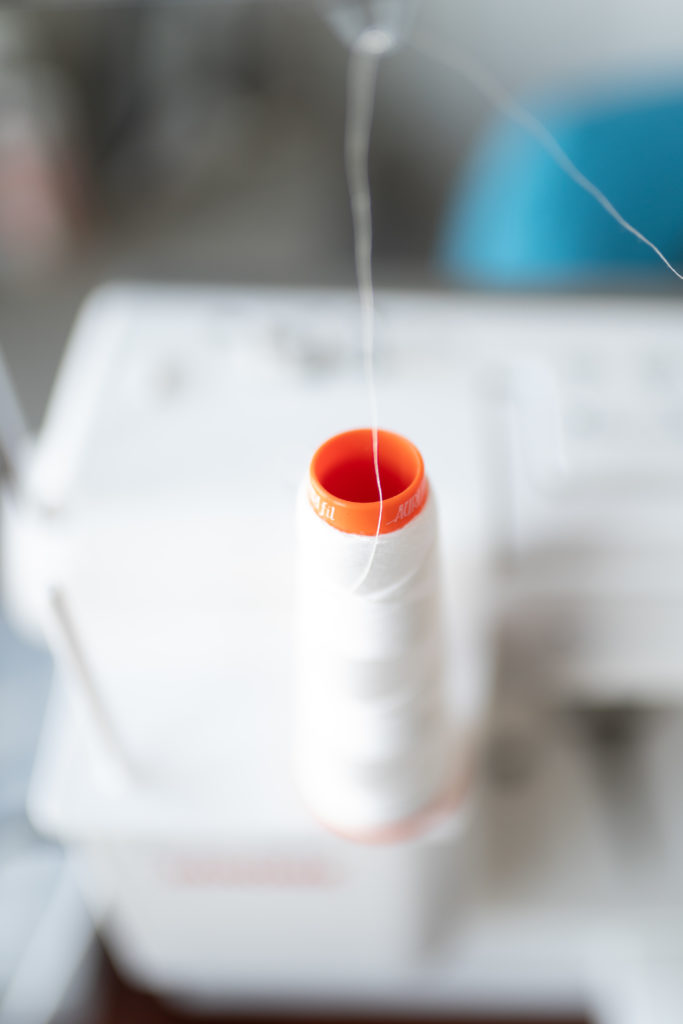
Must Have #4
Thread snips. These little scissors are so hand and I always keep one pair right next to my machine. Here brand doesn’t matter so much, just find a pair that is sharp and feels good in your hands.
Must Have #5
A sharp seam ripper. Seriously, a sharp, small seam ripper is one of my best friends. When you mess something up (and you will!) you want to make sure you can take it apart quickly and fix it. I love my Clover seam ripper. Super inexpensive, small, and best of all, super sharp. I buy these in bulk just to have extras. I use mine every time I sew.
Must Have #6
Steam Iron. Ok know, lots of my quilting friends are all over the map with this one. There is a line drawn in the sand and some of us are on the side of steam and others are firmly on the side of a dry iron. I like steam. As you make more projects and get to know your own preferences, you will figure out what side of the line you fall on. BUT, to start out you don’t need anything fancy. Get an iron that feels good in your hand and has good steam. If you eventually end up in the dry iron camp, you can always just use it dry. I have a Reliable Iron that I love, but I have also had good Rowentas. If you go cheaper, just know that you might have to replace it more often. Getting the most expensive iron isn’t necessary though. There are some lemons in every brand. The biggest factor for my iron longevity has been how many times I knock it off my pressing surface. Ha ha ha. I wish I were kidding, but I’m not. If you drop you iron a lot, just get a cheap one as you will be replacing it often anyway.
Must Have #7
Rotary Cutter and Mat. It’s hard to put a price on these wonderful, glorious tools. They help you be efficient in cutting out your fabric. Imagine hand cutting 2300 rectangles to make a log cabin quilt. I’ve done that before, and there is no way I would even attempt it if I couldn’t do it quickly and accurately with a rotary cutter and mat. I have had several brands, and I like Olfa, Riley Blake, and Creative grids the best. My Fiskars mat was ok, but it wore out more quickly that I feel like it should, and it wasn’t as self healing as I would have liked. Any brand will do though, as long as you promise me right now that you will replace it often. And by often I mean once you wear out some or all of the lines on it. That can be once a year if you are making 30-50 quilts a year like me or every 5 years if you don’t sew a lot. Just don’t let it get too bad before you get a new one. As for size, if you are just starting you don’t need to go huge, just get a 24″ x 18″ and call it good. I like my 24″ x 36″, but I have space for it. You can even get a 24″ x 18″ mat that folds in half for easy storage if you are short on space.
There are lots of choices for rotary cutters too, but just get one that you like the feel of and works for your process. Some of them have buttons that you push as you cut that self retract the blade when you are done, others like mine have a cover you have to manually move back in place with your thumb once you are done. Just PROMISE me that you will ALWAYS close the cutter when you are done. They are sharp and many a quilter has had chunks of their fingers cut off or lots of stiches after a bad cut. Not only is that a travesty for the fabric (all that blood!), no one needs an ER visit for a quilting related injury. CLOSE YOUR BLADES every time.
Speaking of blades, change them often, more often than you think you need to. They are sharp, yes, but fabric dulls them quickly and once you have to take a second pass because parts of the fabric didn’t cut, its time to switch it out.
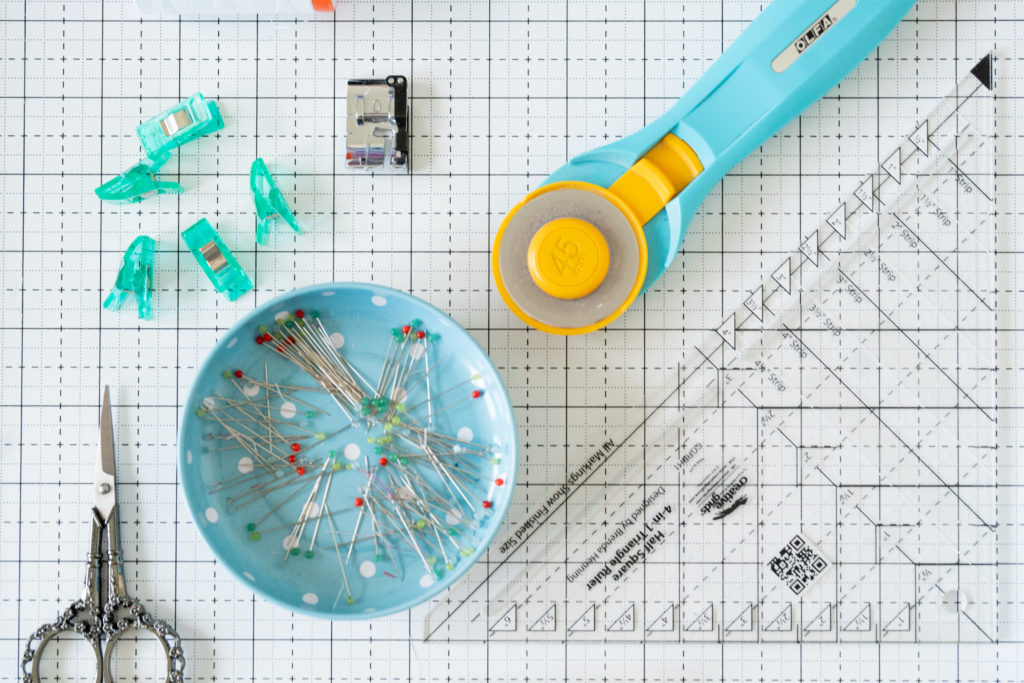
Must Have #8
Rulers! Right along with a rotary cutter and mat, you need clear, acrylic, quilting rulers to go with them. I ADORE my rulers. I have so many different ones that I use for different things, but my favorites are an 6.5″ x 24″ ruler for cutting yardage and strips, a 2.5″ x 18″, and my tiny 2.5″ x 6.5″. These are the ones I have out most often. If you are just starting and can only get one, get the 6.5″ x 24″ its big and can do almost any job you need it to do.
Specialty rulers, like my favorites for half square triangles are also super handy. They aren’t essential, but they are so useful and save me tons of time and fabric. Using rulers like this is something I am still trying to convince experienced quilters to switch over to because I love them so much and they save me so much time and effort. For example, when making a half square triangle traditionally, you cut out a square of fabric, pair it with another the same size, draw a line diagonally from corner to corner, sew 1/4″ on either side of that line, cut on the line, press the units, then trim them to the desired size. Even typing all that out made me cringe. Instead with the HST ruler, you cut out strips, cut the triangles, sew them together, and press. THATS IT! It is so much faster and more accurate. I am biased though, because I hate to trim. The HST’s I make with these rulers come out exactly the size I need so there is no trimming. Happy face.
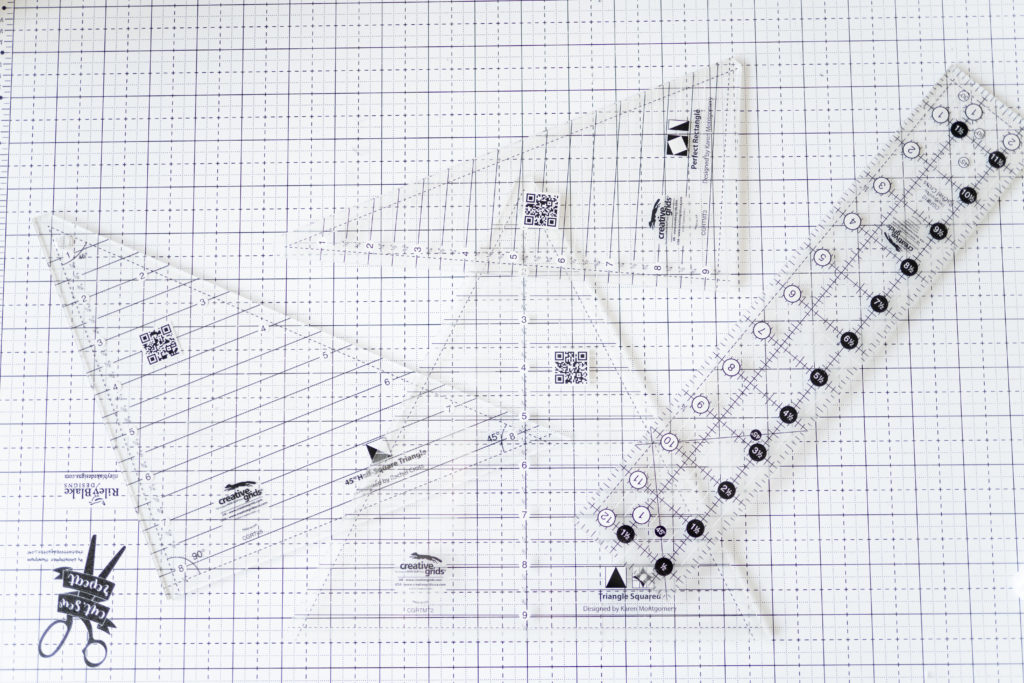
Must Have #9
1/4″ foot. My machine came with one of these, but yours might not. Go to your local quilt shop (that sells machines) and tell them what machine you have. They can help you find a foot if you don’t have one that will work. My favorite has a guide on the side (that rhymes!) that makes it so I can’t move the fabric any further to the right. This helps me keep my seam allowance consistent. There are many other quilters that prefer a 1/4″ foot that DOESN’T have a guide. Just try a few and figure out what you like best. They usually aren’t too pricey, and you can even order them from Amazon. Just make sure you get the right attachment. My Juki is a high shank machine so I need a different foot for it then my low shank Janome.

Must Have #10
Helpful Notions. I’m going to cheat here. I wanted to have 10 essential tools on my list so this one is going to be a three for one deal. Pins and clips, diagonal seam tape, and glue.
Pins and clips are pretty obvious too, to be honest, but the binding clips didn’t exist when I started and they are super helpful. Every sewer needs good pins too. My favorites are Little House glass head pins, because they are so sharp and super slim. Some pins can get really bulky and leave really big holes in your fabric. Try a few kinds and see what you like. The clips I like are the Wonder Clips from Clover. These are super helpful as you bind quilts especially, but they are also useful for regular piecing and especially making bags. They hold more fabric and they don’t stab you. Bonus.
Diagonal seam tape is one of those things that isn’t really essential, but I wouldn’t want to be with out it either. This is washi tape printed with a red center line and two black lines 1/4″ away on either side. I place it on my sewing machine leading up to the needle and it helps me sew snowball corners without marking lines (can you tell yet that I don’t like doing a lot of things?).
Glue is a little random, but hear me out. Washable school glue is awesome when it comes to lots of things. I use it to make my binding strips, baste hard to manage seams, and make sure my seam doesn’t move with small pieces. I use a Fineline glue applicator tip on a regular bottle of Elmers and I am good to go. The tip distributes a fine line of glue that I then heat set with my iron and the seam will stay exactly where I want it.
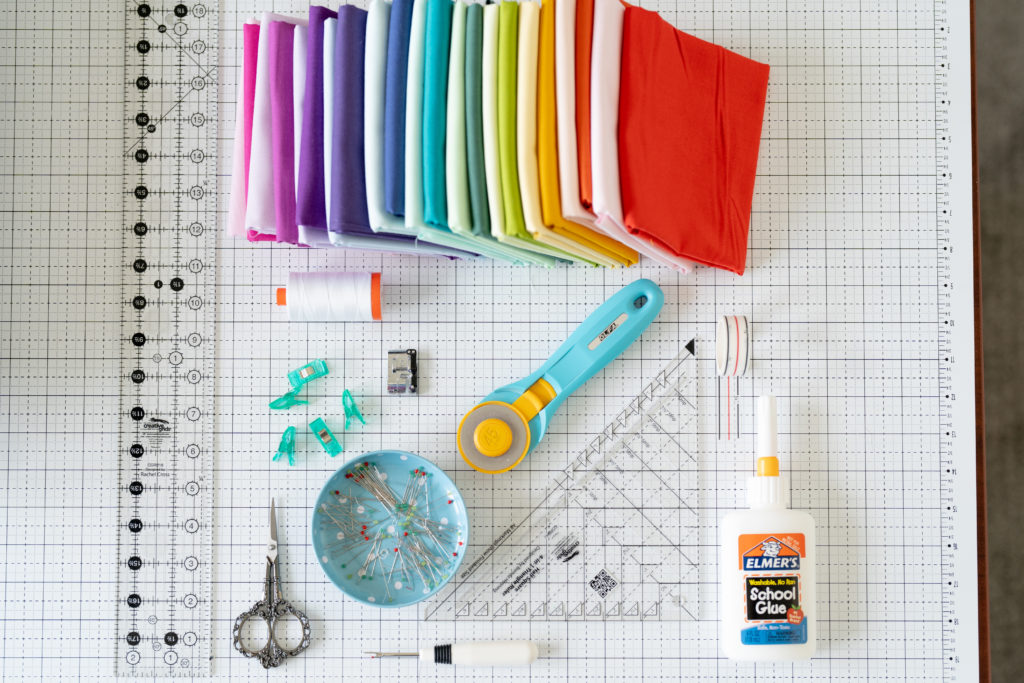
So, there you have it folks! I hope that this will prove helpful for you. If you are just starting out, please know that you don’t need all the best everything right off the bat. Do quality tools matter? Boy howdy, yes they do. But if you are in a pinch or just want to wet your feet, do what you gotta do.
As always, don’t be afraid to ask if you need some help! Reach out via email, on Instagram or Facebook and I would be happy to help you.

you said: